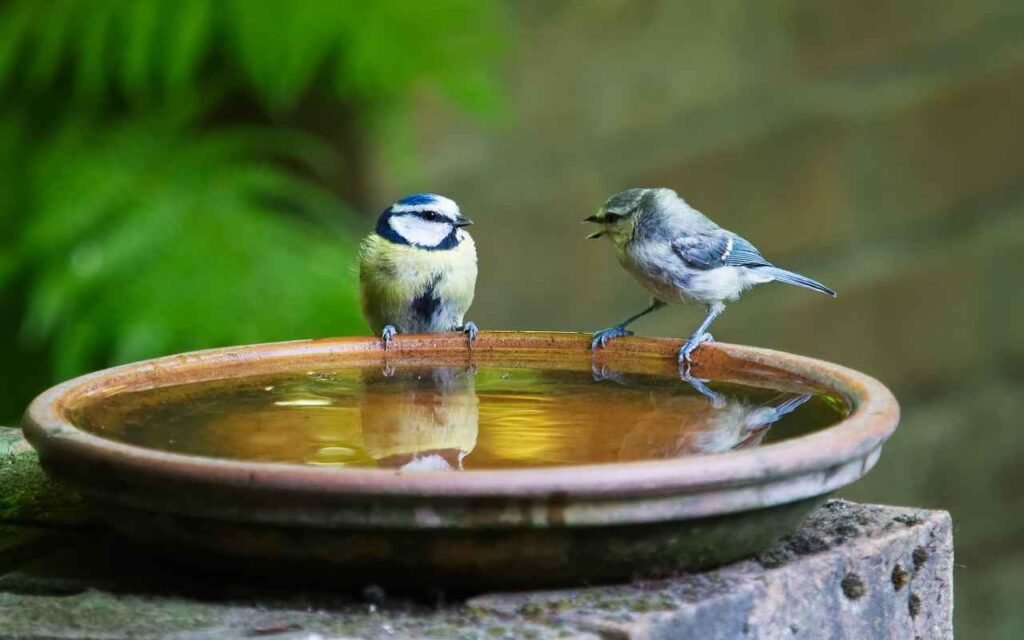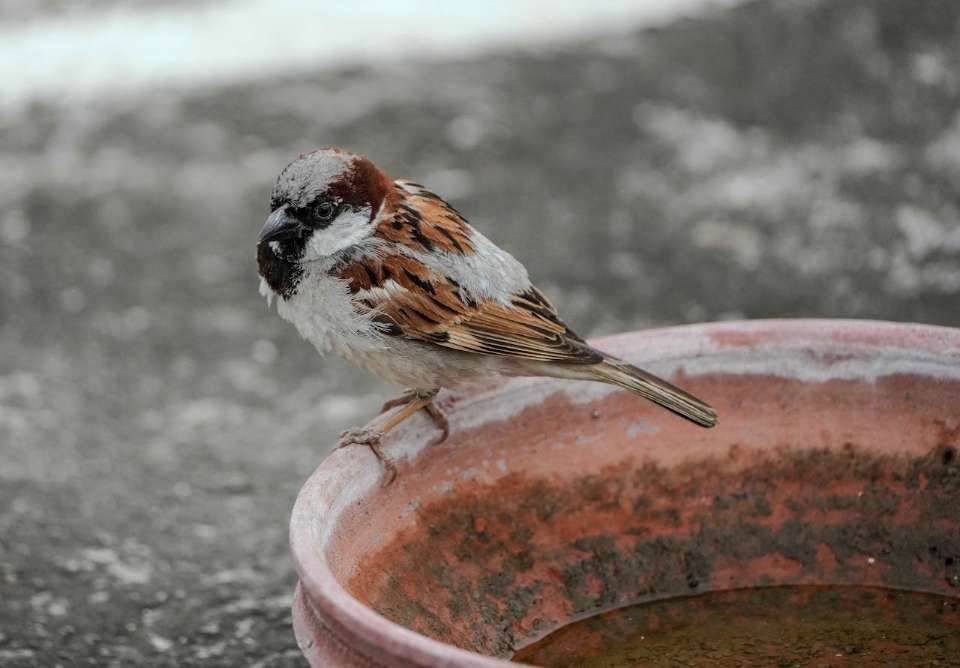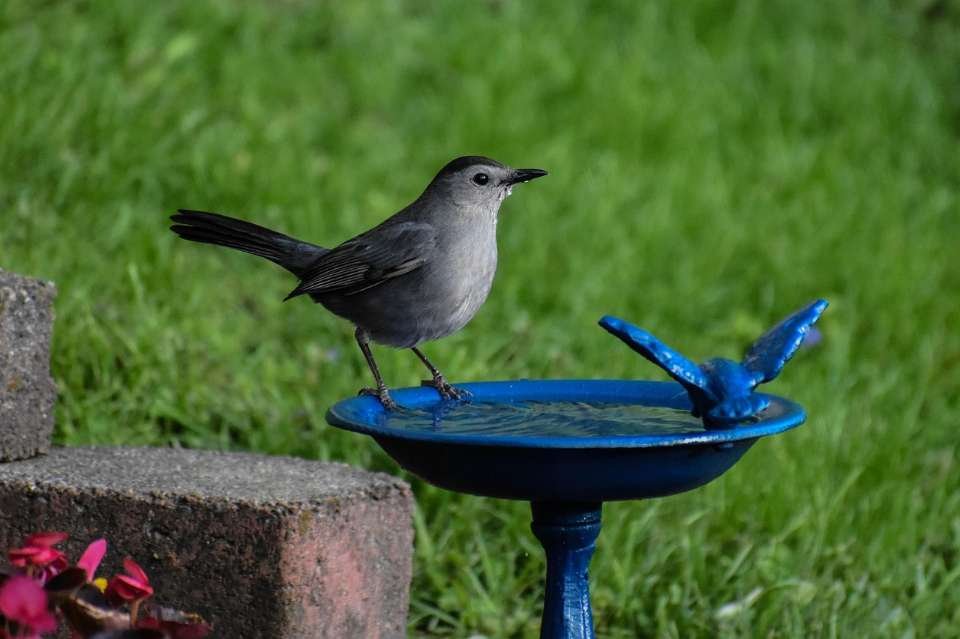You stare at your bird bath and wonder when exactly it transformed from a pristine water feature into what looks like a science experiment gone wrong 😳. That green, slimy coating wasn’t there last week, was it? And what’s that weird film floating on top that makes the water look like a gas station puddle? I’ve been there, friend.
My first bird bath turned into such a disgusting mess that I’m pretty sure the local birds started leaving Yelp reviews warning others to stay away. That’s why I wrote “how to clean a bird bath without chemicals”. After years of trial and error (and some truly horrifying cleaning discoveries), I’ve mastered the art of keeping bird baths spotless without using a single chemical that could harm our feathered visitors.
Why Chemical-Free Cleaning Matters for Bird Health
Birds are incredibly sensitive to chemical residues that we might consider harmless. Even a small amount of cleaner left in a bird bath can irritate a bird’s respiratory or digestive system. Research on feeder hygiene shows that cleaning practices directly affect disease risk in wild birds. A study in The Wilson Journal of Ornithology, highlighted by The Cornell Lab’s Project FeederWatch, found that dirty feeders can harbor bacteria like Salmonella if they aren’t cleaned regularly.
This points to the need for safe, regular cleaning for both feeders and bird baths, while avoiding harsh chemicals that could harm the birds you’re trying to help.
This evidence underscores the importance of safe, regular cleaning — not only for feeders but also for bird baths — while avoiding harsh chemicals that could harm the very birds we’re trying to help.
Even “mild” household cleaners can cause serious health problems for birds who drink from treated water sources. Soap residues, bleach traces, and commercial disinfectants can damage their delicate digestive systems and respiratory tracts. We’re talking about creatures who can be poisoned by Teflon fumes from cooking pans, so you can imagine how seriously we need to take cleaning product safety.
Chemical-free cleaning protects not just the birds using your bath, but also the insects, amphibians, and other small wildlife that depend on clean water sources. Plus, natural cleaning methods are often more effective than harsh chemicals for removing the specific types of buildup that occur in bird baths.
The Hidden Dangers of “Bird-Safe” Products
Many products marketed as “bird-safe” still contain ingredients that can cause problems for sensitive species. Essential oils, citrus extracts, and some plant-based cleaners can affect birds’ respiratory systems or leave residues that impact water quality. Dial A Vet notes that even natural extracts can pose health risks for birds.
The safest approach involves using materials you probably already have in your kitchen and cleaning supplies. Hot water, white vinegar, baking soda, and good old-fashioned elbow grease can tackle any bird bath cleaning challenge without putting your feathered friends at risk.
Daily Maintenance: Prevention Beats Cleanup Every Time
Fresh water changes every 2-3 days prevent most serious cleaning problems before they start. Fresh water changes every 2–3 days prevent most serious cleaning problems before they start. According to Nature Canada, changing the water every day or two also helps prevent disease spread and algae buildup. This simple routine stops algae growth, prevents bacterial buildup, and keeps your bird bath looking and smelling fresh.
I learned this lesson the hard way after going on a week-long vacation and returning to find my bird bath had turned into what I can only describe as primordial soup. The smell alone could have knocked out a vulture. Trust me, prevention is way easier than recovery.
Quick daily checks take less than 30 seconds but make a huge difference in long-term maintenance. Remove any debris like fallen leaves, seeds, or the occasional unfortunate insect that decided to take a permanent swim.
The Morning Routine That Works
Start each day with a visual inspection of your bird bath while you’re getting your morning coffee. Look for obvious debris, check water clarity, and note any changes in water level that might indicate problems.
Use a small net or your hands to remove floating debris before it sinks and starts decomposing. Leaves, twigs, and seed hulls can create serious water quality problems if left to rot in the basin.
Top off water levels as needed to maintain proper depth and ensure fresh circulation. Birds prefer water that’s 1-2 inches deep, and maintaining consistent levels helps prevent stagnation.
The Basic Hot Water Deep Clean Method
Hot water alone removes most bird bath buildup without requiring any additional cleaning agents. This method works particularly well for regular maintenance cleaning when algae and bacterial films haven’t had time to become seriously established.
Heat a large pot of water to near-boiling temperature and carefully pour it over all surfaces of your bird bath. The hot water kills bacteria, loosens organic buildup, and makes scrubbing much more effective.
Scrub all surfaces with a stiff brush while the bath is still warm from the hot water treatment. An old toothbrush works perfectly for getting into decorative details and tight corners where buildup tends to accumulate.
The Technique That Gets Results
Start scrubbing from the top and work your way down, allowing gravity to help remove loosened debris and buildup. Pay special attention to the waterline area where organic films tend to be thickest.
Rinse thoroughly with clean water after scrubbing to remove all loosened material. Check for any remaining buildup and repeat the hot water treatment if necessary.
Allow the bath to air dry completely before refilling with fresh water. This drying period helps eliminate any remaining bacteria and gives you a chance to inspect for areas that might need additional attention.
White Vinegar: The Algae-Busting Powerhouse
White vinegar dissolves algae, mineral deposits, and bacterial films more effectively than most commercial cleaners, and it’s completely safe for birds when used properly. The acetic acid in vinegar breaks down organic buildup without leaving harmful residues. The Audubon Society also recommends using a vinegar-and-water solution to safely keep birdbaths clean.
Mix equal parts white vinegar and hot water for tough cleaning jobs, or use straight vinegar for serious algae problems. Pour the solution into your bird bath and let it sit for 15-20 minutes to allow the acid to work on stubborn buildup.
Scrub with a brush after the vinegar treatment to remove loosened algae and deposits. The combination of acid treatment and mechanical scrubbing handles even the most challenging cleaning situations.
Dealing with Stubborn Mineral Deposits
White vinegar excels at removing mineral deposits left by hard water or mineral-rich well water. These white, chalky deposits can make bird baths look terrible and affect water quality if allowed to accumulate.
Soak paper towels in straight vinegar and apply them directly to heavy mineral buildup areas. Let them sit for 30 minutes, then scrub with a brush to remove dissolved deposits.
For extremely stubborn deposits, repeat the vinegar treatment multiple times rather than trying to scrub harder. Patience and repeated acid treatments work better than brute force and protect your bird bath’s finish.
Baking Soda: The Gentle Abrasive Solution
Baking soda provides gentle abrasive action that removes buildup without scratching delicate bird bath surfaces. This makes it perfect for cleaning decorative bird baths with painted or glazed finishes that could be damaged by harsh scrubbing.
Create a paste using baking soda and just enough water to form a thick, spreadable mixture. Apply this paste to stained or heavily soiled areas and let it sit for 10-15 minutes before scrubbing.
The alkaline properties of baking soda neutralize acidic bird droppings and organic waste that can create persistent odors and stains. It’s particularly effective for cleaning the areas around bird baths where droppings tend to accumulate.
Combining Vinegar and Baking Soda
The classic volcano science project reaction actually works wonders for bird bath cleaning when used strategically. Sprinkle baking soda over stubborn stains, then add white vinegar to create a bubbling action that helps lift buildup. According to Birdfy, this combination effectively removes tough bird droppings and buildup without harming your feathered visitors.
Let the reaction bubble for 5-10 minutes, then scrub with a brush to remove the loosened material. This combination handles the most challenging cleaning situations while remaining completely bird-safe.
Always rinse thoroughly after using this method to remove all residue and neutralize any remaining cleaning agents. The goal is to leave behind only clean surfaces and fresh water.
Seasonal Deep Cleaning Strategies
Different seasons create different bird bath cleaning challenges that require adjusted approaches and timing. Understanding these seasonal patterns helps you stay ahead of problems and maintain consistently clean water for your feathered visitors.
Spring cleaning removes winter accumulation of debris, mineral deposits, and any bacterial growth that occurred during periods of reduced maintenance. This is when you’ll want to do your most thorough cleaning of the year.
Summer maintenance focuses on algae prevention and frequent water changes to combat the rapid bacterial growth that occurs in warm weather. Hot, sunny conditions can turn clean water into green soup within days if you’re not staying on top of things.
Winter Maintenance Challenges
Frozen bird baths require special cleaning considerations when using heated elements to provide liquid water. Ice formation can trap debris and concentrate minerals, creating cleanup challenges when things thaw out.
Clean heated bird baths more frequently during winter since the constant warmth can accelerate bacterial growth even in cold weather. The combination of heat and organic matter creates perfect conditions for unwanted microorganisms.
IMO, winter bird bath maintenance is the most challenging season, but it’s also when clean water becomes most valuable to local bird populations struggling with frozen natural water sources.
Tools and Equipment: Building Your Chemical-Free Cleaning Kit
You don’t need fancy equipment to maintain a spotless bird bath using natural cleaning methods. A few basic tools and household items will handle any cleaning challenge you encounter.
Essential cleaning tools include:
• Stiff-bristled brush for scrubbing (old toothbrushes work great)
• Small net or strainer for removing floating debris
• Spray bottle for applying vinegar solutions
• Rubber gloves to protect your hands during cleaning
• Old towels or rags for drying and polishing
• Large bucket for mixing cleaning solutions
Avoid using anything abrasive like steel wool or harsh scrubbing pads that could scratch your bird bath’s surface and create areas where bacteria can hide and multiply.
Storage and Organization Tips
Keep your bird bath cleaning supplies together in a dedicated container or caddy so you can quickly access everything when it’s time for maintenance. I use an old plastic bucket that holds all my supplies and doubles as a mixing container for cleaning solutions.
Store white vinegar and baking soda in clearly labeled containers near your bird bath supplies so you never have to search around when you notice cleaning issues developing.
Troubleshooting Common Cleaning Problems
Different types of buildup require different cleaning approaches, and recognizing what you’re dealing with helps you choose the most effective natural cleaning method for each situation.
Green algae responds best to vinegar treatments combined with increased water circulation and partial shade to prevent regrowth. Algae loves sunlight and stagnant water, so addressing those conditions solves the root problem.
Slimy bacterial films require hot water treatment followed by thorough scrubbing and complete water replacement. These films can develop quickly in warm weather and create health risks for visiting birds.
When Natural Methods Aren’t Enough
Extremely neglected bird baths sometimes require multiple cleaning sessions to return to pristine condition. Don’t expect miracles on the first try if you’re dealing with months of accumulated buildup.
Consider temporary removal of severely contaminated water and allowing the basin to dry completely between cleaning sessions. This breaks the cycle of recontamination and gives you a fresh start.
Persistent odor problems may indicate deeper bacterial colonization that requires repeated treatments and possibly professional cleaning advice if natural methods don’t resolve the issue.
The beauty of chemical-free bird bath cleaning lies in its simplicity and safety. These natural methods protect the birds we love while keeping our backyard water features sparkling clean and inviting. Your feathered friends will appreciate the effort, and you’ll feel good knowing you’re providing them with the safest possible environment for drinking and bathing 🙂




